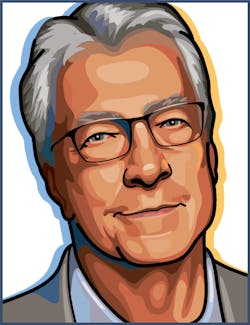
March should be designated International Telecommunications Month--it's the traditional date for the OFC Conference and Expo and, in March 1989 Tim Berners-Lee, a scientist working at CERN, submitted a proposal to develop a radical new way of linking and sharing information over the internet.
From that document--Information Management: A Proposal--the World Wide Web was born. The first website was at CERN and last April CERN initiated a project to restore it and to bring back the spirit of that time through its technical innovation and the founding principles of openness and freedom.
In 1993, CERN put the World Wide Web software in the public domain--and we know the rest. Tim Berners-Lee, the World Wide Web Consortium (W3C), and the World Wide Web Foundation are now launching a series of initiatives to mark the 25th anniversary. In addition, Berners-Lee and the Web Foundation are launching "The web we want" campaign to promote a global dialogue and change in public policy to ensure that the web remains an open, free, accessible medium.
Meanwhile, back at the WWW infrastructure meeting in San Francisco this week, aka, OFC, there were 800 presentations, 550 exhibitors, and 12,700 attendees. Hot topics were space-division multiplexing, silicon photonics, 1 Tb/s optical networking, data centers, photonics integration, 100G+ coherent transmission, and software-defined networking.
Of particular note was the OpenOptics multi-source agreement, a consortium founded by Mellanox Technologies (NASDAQ: MLNX) and Ranovus to standardize wavelength division multiplexing (WDM) for an interoperable 100G WDM standard for 2-km reach. The OpenOptics multi-source agreement combines 1550-nm WDM laser and silicon photonics for QSFP-based solutions, and is intended to enable the lowest cost, highest density, and highest bandwidth single-mode fiber connectivity.
Speaking of silicon photonics, our colleague Stephen Hardy, editorial director at Lightwave, has written some good coverage of recent trends in silicon photonics:
Silicon photonics, one year later
IBM discusses silicon photonics commercialization strategy
For the basics on silicon photonics, read this article by LFW contributing editor Jeff Hecht, who has been covering fiber optics since before the founding of the WWW:

Conard Holton
Conard Holton has 25 years of science and technology editing and writing experience. He was formerly a staff member and consultant for government agencies such as the New York State Energy Research and Development Authority and the International Atomic Energy Agency, and engineering companies such as Bechtel. He joined Laser Focus World in 1997 as senior editor, becoming editor in chief of WDM Solutions, which he founded in 1999. In 2003 he joined Vision Systems Design as editor in chief, while continuing as contributing editor at Laser Focus World. Conard became editor in chief of Laser Focus World in August 2011, a role in which he served through August 2018. He then served as Editor at Large for Laser Focus World and Co-Chair of the Lasers & Photonics Marketplace Seminar from August 2018 through January 2022. He received his B.A. from the University of Pennsylvania, with additional studies at the Colorado School of Mines and Medill School of Journalism at Northwestern University.